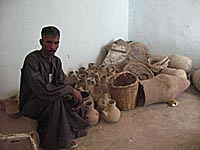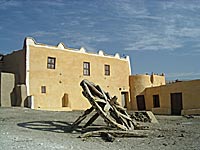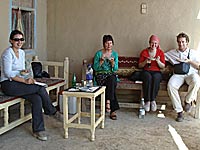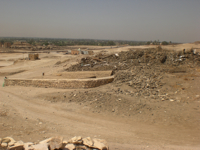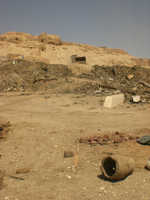Good News Update November 2018
Permanent exhibitions Open again.
After many years in boxes and cupboards, the Exhibitions are up again and visible to all who visit Balady Handicraft Centre http://www.baladyhandicraft.com. The Centre is in As-Siyul, the furthest of the new settlements, but only 6 km to the North. You can take a local mini-bus from the mini-bus station near the ferry.
We have had copies of two wonderful Hay panoramas of Qurna now held in the British Library on display since the start of Qurna Discovery, but we now have a copy of a third panorama, this time painted in a wash rather than just drawn. The artist was sitting at the top of the hill that is Sheikh abd el Qurna, and you can see round to groups of people visiting the shrine of the Sheikh. This was sold in London a few years ago for £15,000. It was sold again by Christies in January 2018, and this time it fetched £35,000! We do not know who the buyer was, but we are glad that Hay's work is valued so highly - though it would have been so much better if the Library had been able to buy it to join its fellows.
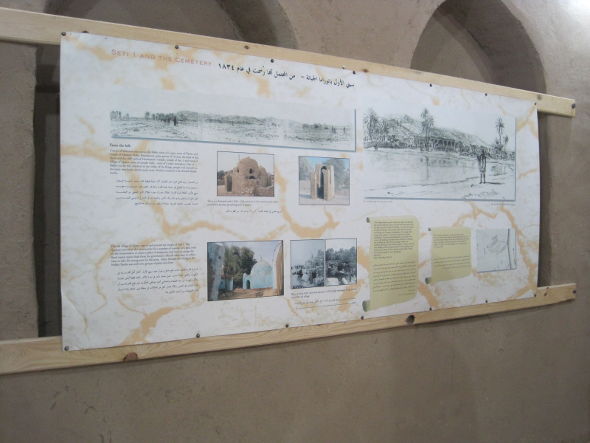
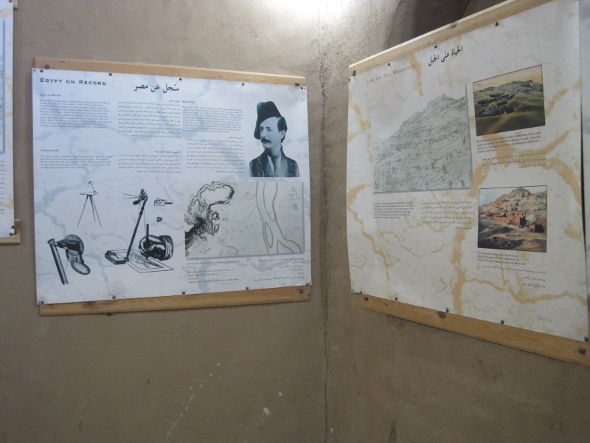
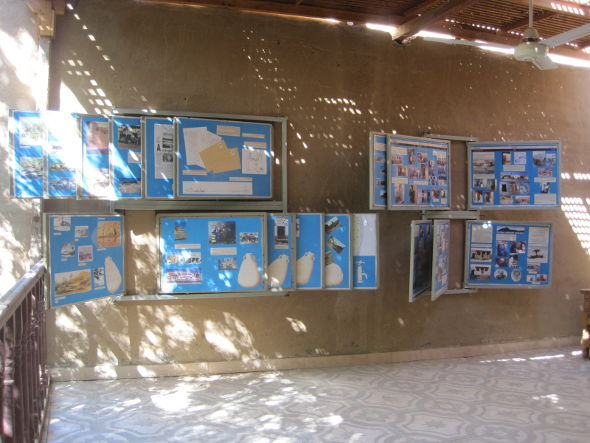
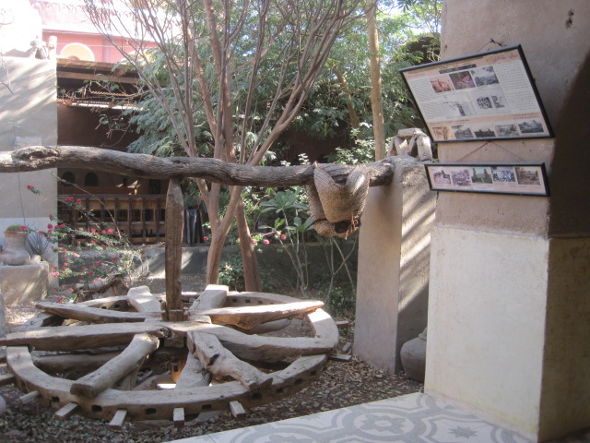
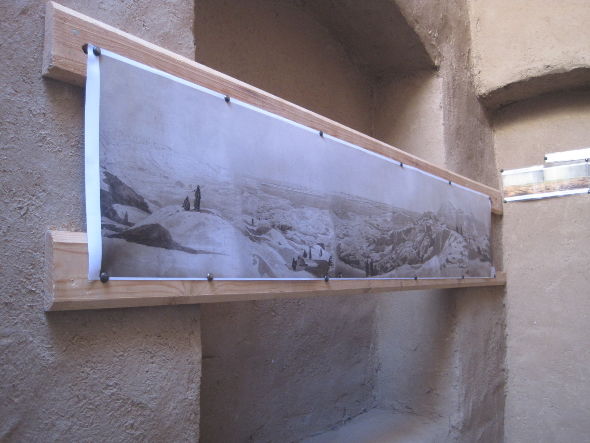
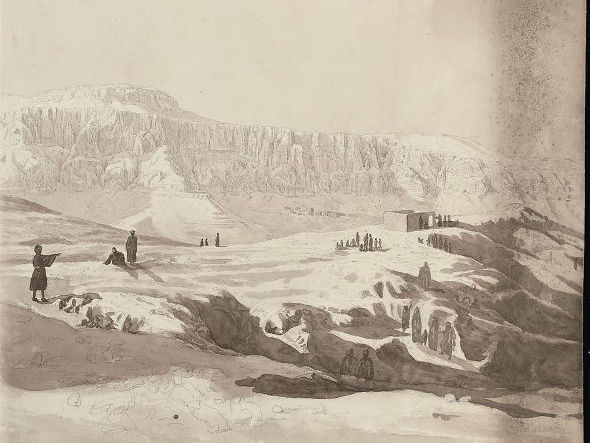
The Thresher panel.
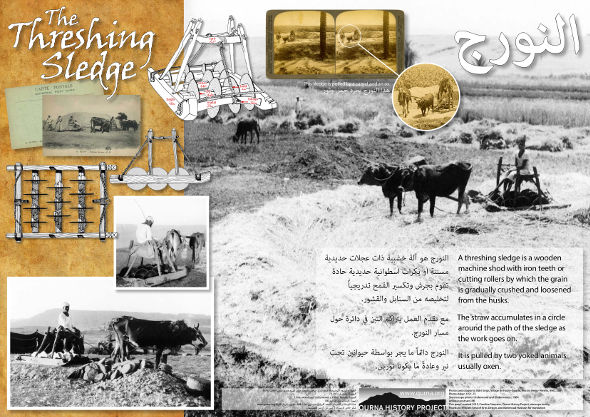
Abdu Daramalli rescued an antique thresher that is now on display at the Balady Centre. I put together a display panel to illustrate the use and history of the thresher. Thank you to Tristram Ariss for the design and layout.
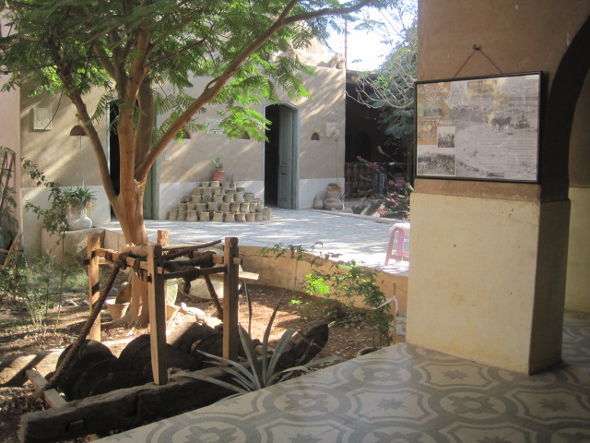
Qurna Discovery buildings were demolished in May 2010.
The exhibitions have been removed to Balady Handicraft Qurna, where every effort will be taken to display as many as possible. See: http://www.baladyhandicraft.com/
The information below is now history - yet another part of the vanished history of Qurna.
Permanent Exhibitions Open, June 2008
CLOSED PERMANENTLY MAY 2010
Qurna Discovery enables local people and visitors to understand and appreciate aspects of Qurna heritage and society.
Qurna Discovery is a small permanent venue in the Nobles Tombs area on Sheikh abd el Qurna, the area of the Theban Hills opposite the Ramesseum.
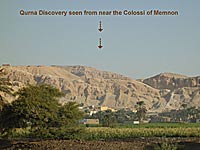
The exhibitions are permanent and entry is Free.
Free entry means that local people are encouraged to visit, school parties are welcome, and tourists can painlessly learn something about the Qurnawi community and might be encouraged to buy some local crafts or contribute in some way to the local economy.
How to get there:
- By car – park in the Nobles’ Tombs car park opposite the Ramesseum, and then walk.
- On foot – walk to the Nobles’ Tombs, then walk up the hillside as if to the tomb of Nakht, to the left you will find Qurna Discovery. Sit on a verandah to admire the view and take your breath before you visit the exhibitions.
The left hand building, the Zawyet bet Khalil, houses two main exhibitions, and two smaller ones.

The Daramalli House - the right hand building - is being prepared for public view. It will house a collection of traditional furniture, household and agricultural implements so that you can learn about Qurnawi family life.
Life on the Theban Hills 1826
The fascinating drawings of Robert Hay (2001)illustrates local history through the early 19th century drawings.
Robert Hay was an artist and draughtsman who worked in Egypt in the 1820s and 30s and who spent many years drawing the tombs and temples. He made a number of detailed drawings of the whole area, including the two stunning 360 degree panoramas. They are part of a huge collection, The Hay Manuscripts, which are mainly of Egyptological interest. However the drawings that form the content of this exhibition are every-day scenes of the 1820's in Qurna. For years the drawings have been hidden away, seen by very few people. Now the British Library, who keep the drawings, have given permission for an exhibition of the drawings to be held at the very place that they were drawn - Qurna in Egypt.
How did the project start?
The project co-ordinator, Caroline Simpson says:
"While researching the history of the village I came across these wonderful drawings and friends in Qurna asked if I could find a way for the Qurnawi to see them too. I decided to ask the British Library and take it from there."
The British Library generously donated a set of photographic copies of a selection of the Hay drawings to the people of Qurna. Then a venue had to be found, and money raised to make it all happen.
Click here for samples of the
Theban drawings
Why are they so special?
They form perhaps the most detailed record of village life of that period anywhere in the world, they are unpublished, and are now displayed in that village for locals and visitors to see. This is even more important in an area of such historical significance, where so much is known and taught about the ancient history. History does not stop at some given date in the Roman period. These records are as valid as wall paintings and papyrus - and as beautiful.
The second exhibition is - Gourna - living villages in the city of the dead
This exhibition looks at the current state and modern problems of the hillside ommunity. This exhibition was made in 1997 in answer to requests from people in Qurna to help them in their struggle to remain in their old houses on the hillside. It is designed as a tool to inform and encourage their own discussion amongst the families on the hillside, to use to explain the history of their problem when discussing it with the authorities, and to show to tourists so that they too understand the social history and problems that the people face in this world heritage site. In order to begin to analyse today's problems, it was necessary to research the past, and it was in this research that the whole Qurna History Project began, and the Hay drawings were found.
This exhibition has also been shown in Cairo at the American University, and in Cambridge University, England, at a conference of the Association for the Study of Travel in Egypt and the Near East.
|
|
|
A new exhibit of November 2007
Zawyet bet Khalil
The family meeting houses - zawaya - were distinctive features of the built environmant. They also had important social and community functions. A new exhibit illustrates many of the various zawaya of Qurna and tells the history of this particular one.
Please click here to view the Zawyeh Exhibition Panel.
The English text can be found here
And outside the venue…
In May 2004 Qurna Discovery presented its new display, The Bogdadi sāqiya. A small display about water wheels alongside the 19th century Bogdadi sāqiya wheel.

The outside of our 2002-2007 venue. In May 2004, the well-known cartoonist Golo was commissioned to paint The Qurna Mural on the outside walls of Qurna Discovery.
Sadly this mural is no longer visible. In January 2007 the exhibitions had to move and the shop owners have repainted the building.
The Mural was 'unveiled' with a small party in May 2004. For an article written for Al Ahram Weekly please click here.
Qurna Discovery is open every day except Friday.
8am – 4.00pm.
Entry is free.
(The exhibition is now permanently closed)
Qurna Discovery moved to its current venue in 2007
Due to the relocation of the Qurnawi to a new settlement further north, and the destruction of most of the properties, Qurna Discovery had to move out of its venue in January 2007.
When all the demolitions were going on we obtained permission to retain and restore a unique small group of buildings to use for historical exhibitions, see Articles and Links: The Four Properties Projects
Update 2010: due to misunderstandings and a lack of communication on the ground, further demolitions in 2009 took two of this group. On March 25th Yanni's House, that was the most northern of the four properties we hoped would remain, was demolished by the Government bulldozers. This was a sad day for Qurna history, and for those members of ASTENE who had wished to restore it. And on April 4th the bulldozers returned unannounced and demolished the wonderful mud structures outside the bab el-hagar that Qurna Discovery planned to clean and display. Our team there had put up a valiant struggle and tried to stop both these demolitions, but were not successful.
A new organisation was formed to support the exhibitions and pay for the restoration and re-installation. We would love to welcome you as a Friend of Qurna Discovery.
Restoration and repair went ahead from February to October, and the exhibitions were remounted temporarily August to October. In October the restoration work was all finished and the exhibitions and lighting all properly installed in the zawyeh and adjacent buildings.
Formal written permission was obtained from Dr Zahi Hawass and on November 4th 2007 we had a small Opening party.
There was a problem from late November 2007 to May 2008 when the exhibitions were not open. We apologise to any visitors who had hoped to see them then.
On November 3rd 2008, we received a letter from His Excellency Farouk Hosni, Minister of Culture, giving his personal permission for the use of the buildings by Qurna Discovery, as had been previously agreed with the Supreme Council of Antiquities. He goes on to thank us for our work "for the preservation of the heritage of this remarkable place" and to wish the project well, and offers his help in the future should we need it.
Update May 2010
In spite of these written assurances from Dr Hawass, Secretary General of the Supreme Council of Antiquities, and Deputy Minister of Culture, and the Minister of Culture himself, His Excellency Farouk Hosni, Dr Hawass and colleagues decided in May that these historic buildings should be demolished.
The displays and equipment were moved on May 26th and the two buildings demolished by the bulldozers on May 27th.
There are now no historic Qurnawi buildings on the Sheikh abd el-Qurna hillside. There is nothing to show to visitors that there was a vibrant community with its own culture and history living here for over 200 years.
There are rumours that the authorities want to have a Sound and Light show on the hillside.
For a conference paper of June 2010 which discusses the Qurna demolitions, see
Theban Blindness - a case history of severe archaeological hypermetropia
A paper given at the conference: Disciplinary Measures? Histories of Egyptology in Multi-Disciplinary Context. London, June 2010.

